Investment Appraisal: Financial Analysis and Decision-Making Report
VerifiedAdded on 2023/06/13
|8
|1681
|142
Report
AI Summary
This report provides a comprehensive analysis of investment appraisal techniques and financial decision-making processes. It includes a calculation of the Net Present Value (NPV) for a new project, advising management on its financial viability based on the NPV result, and discussing other critical factors influencing investment decisions such as risk, investment period, liquidity, taxation, inflation rate, and market volatility. The report also addresses the limitations of measures of central tendency (mean, median, mode) and situations where data distribution may not provide a realistic picture. Furthermore, it outlines mathematical tools for appraising capital investment decisions in business, including the payback period, net present value, internal rate of return, and accounting rate of return. The report concludes with a list of references used in the analysis. Desklib provides past papers and solved assignments for students.

Decision making
Paraphrase This Document
Need a fresh take? Get an instant paraphrase of this document with our AI Paraphraser
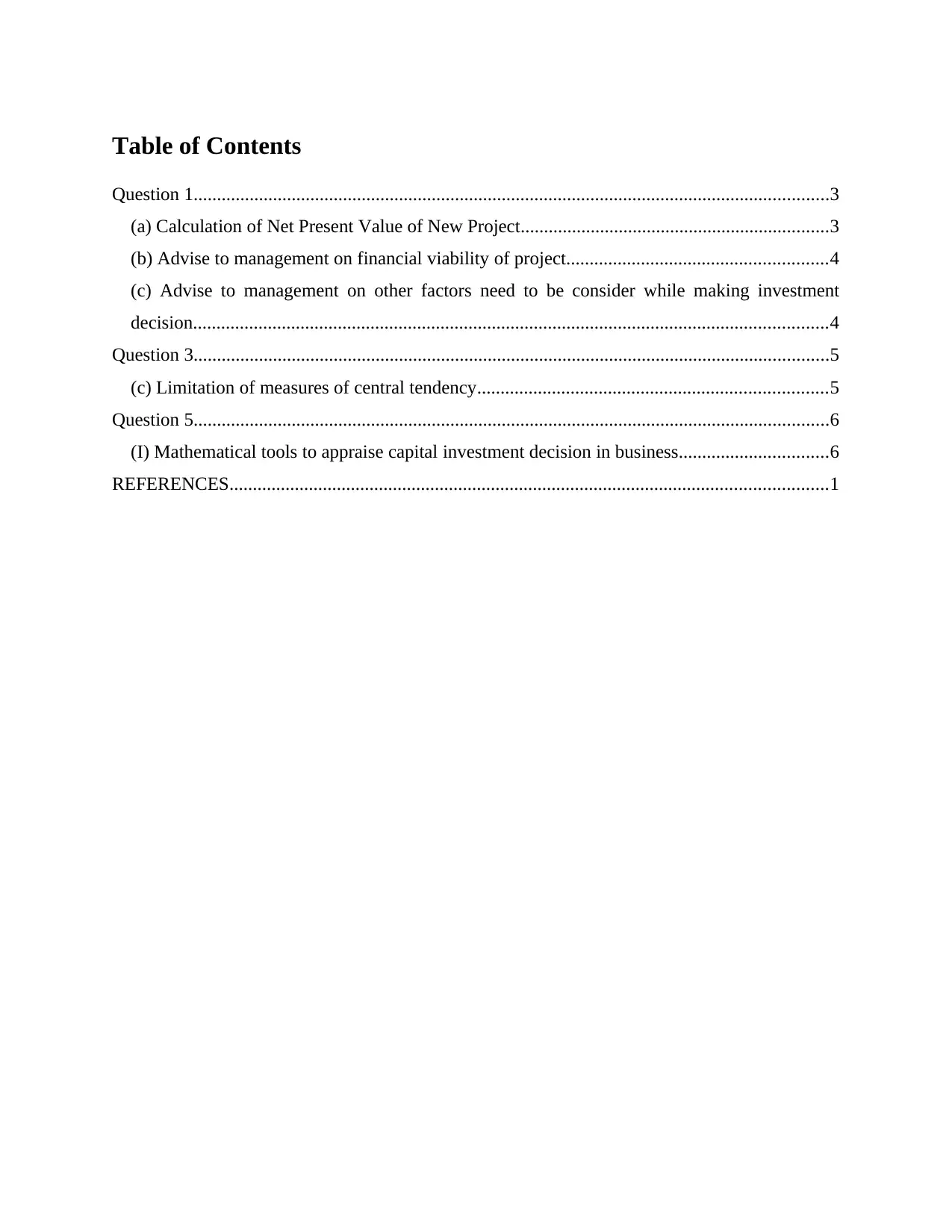
Table of Contents
Question 1........................................................................................................................................3
(a) Calculation of Net Present Value of New Project..................................................................3
(b) Advise to management on financial viability of project........................................................4
(c) Advise to management on other factors need to be consider while making investment
decision........................................................................................................................................4
Question 3........................................................................................................................................5
(c) Limitation of measures of central tendency...........................................................................5
Question 5........................................................................................................................................6
(I) Mathematical tools to appraise capital investment decision in business................................6
REFERENCES................................................................................................................................1
Question 1........................................................................................................................................3
(a) Calculation of Net Present Value of New Project..................................................................3
(b) Advise to management on financial viability of project........................................................4
(c) Advise to management on other factors need to be consider while making investment
decision........................................................................................................................................4
Question 3........................................................................................................................................5
(c) Limitation of measures of central tendency...........................................................................5
Question 5........................................................................................................................................6
(I) Mathematical tools to appraise capital investment decision in business................................6
REFERENCES................................................................................................................................1
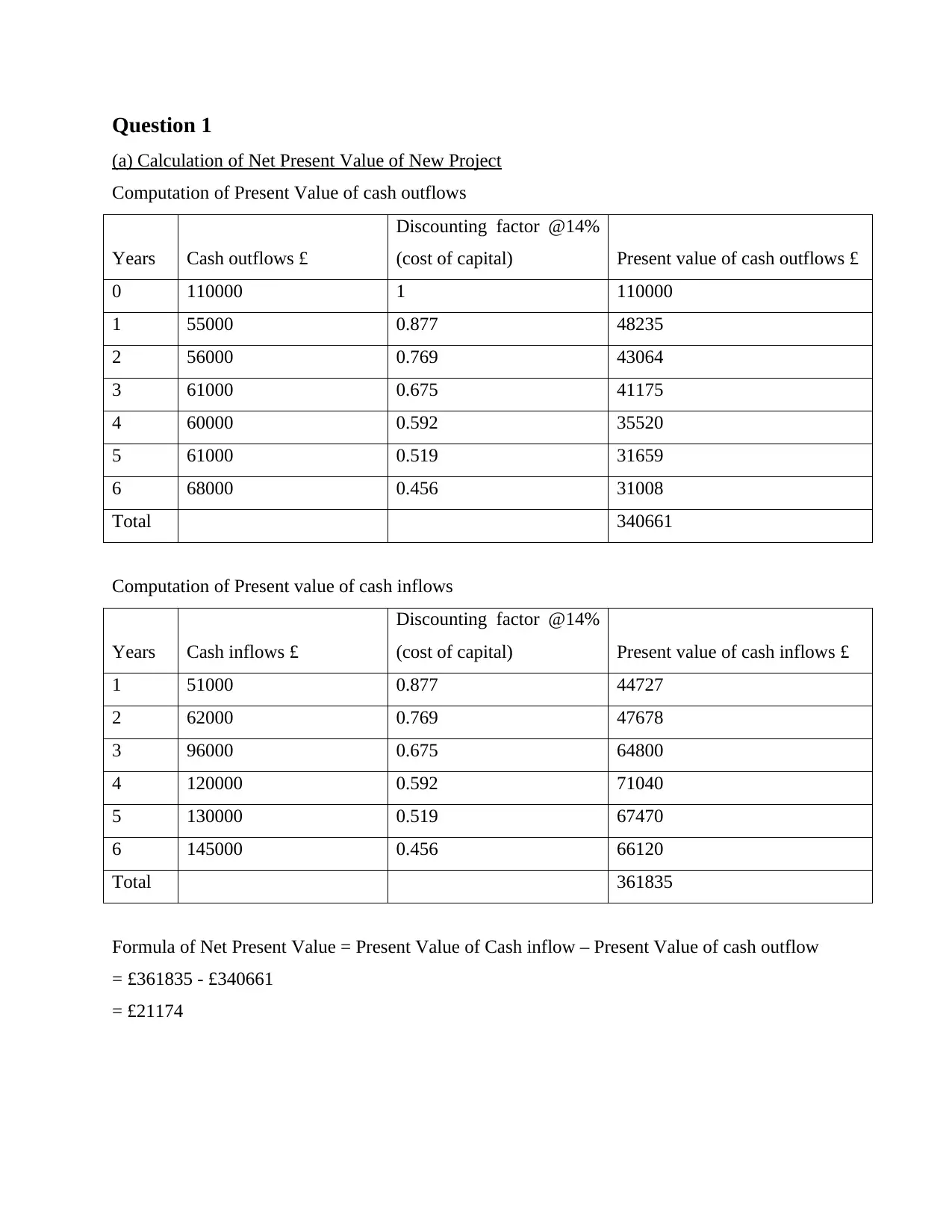
Question 1
(a) Calculation of Net Present Value of New Project
Computation of Present Value of cash outflows
Years Cash outflows £
Discounting factor @14%
(cost of capital) Present value of cash outflows £
0 110000 1 110000
1 55000 0.877 48235
2 56000 0.769 43064
3 61000 0.675 41175
4 60000 0.592 35520
5 61000 0.519 31659
6 68000 0.456 31008
Total 340661
Computation of Present value of cash inflows
Years Cash inflows £
Discounting factor @14%
(cost of capital) Present value of cash inflows £
1 51000 0.877 44727
2 62000 0.769 47678
3 96000 0.675 64800
4 120000 0.592 71040
5 130000 0.519 67470
6 145000 0.456 66120
Total 361835
Formula of Net Present Value = Present Value of Cash inflow – Present Value of cash outflow
= £361835 - £340661
= £21174
(a) Calculation of Net Present Value of New Project
Computation of Present Value of cash outflows
Years Cash outflows £
Discounting factor @14%
(cost of capital) Present value of cash outflows £
0 110000 1 110000
1 55000 0.877 48235
2 56000 0.769 43064
3 61000 0.675 41175
4 60000 0.592 35520
5 61000 0.519 31659
6 68000 0.456 31008
Total 340661
Computation of Present value of cash inflows
Years Cash inflows £
Discounting factor @14%
(cost of capital) Present value of cash inflows £
1 51000 0.877 44727
2 62000 0.769 47678
3 96000 0.675 64800
4 120000 0.592 71040
5 130000 0.519 67470
6 145000 0.456 66120
Total 361835
Formula of Net Present Value = Present Value of Cash inflow – Present Value of cash outflow
= £361835 - £340661
= £21174
⊘ This is a preview!⊘
Do you want full access?
Subscribe today to unlock all pages.

Trusted by 1+ million students worldwide
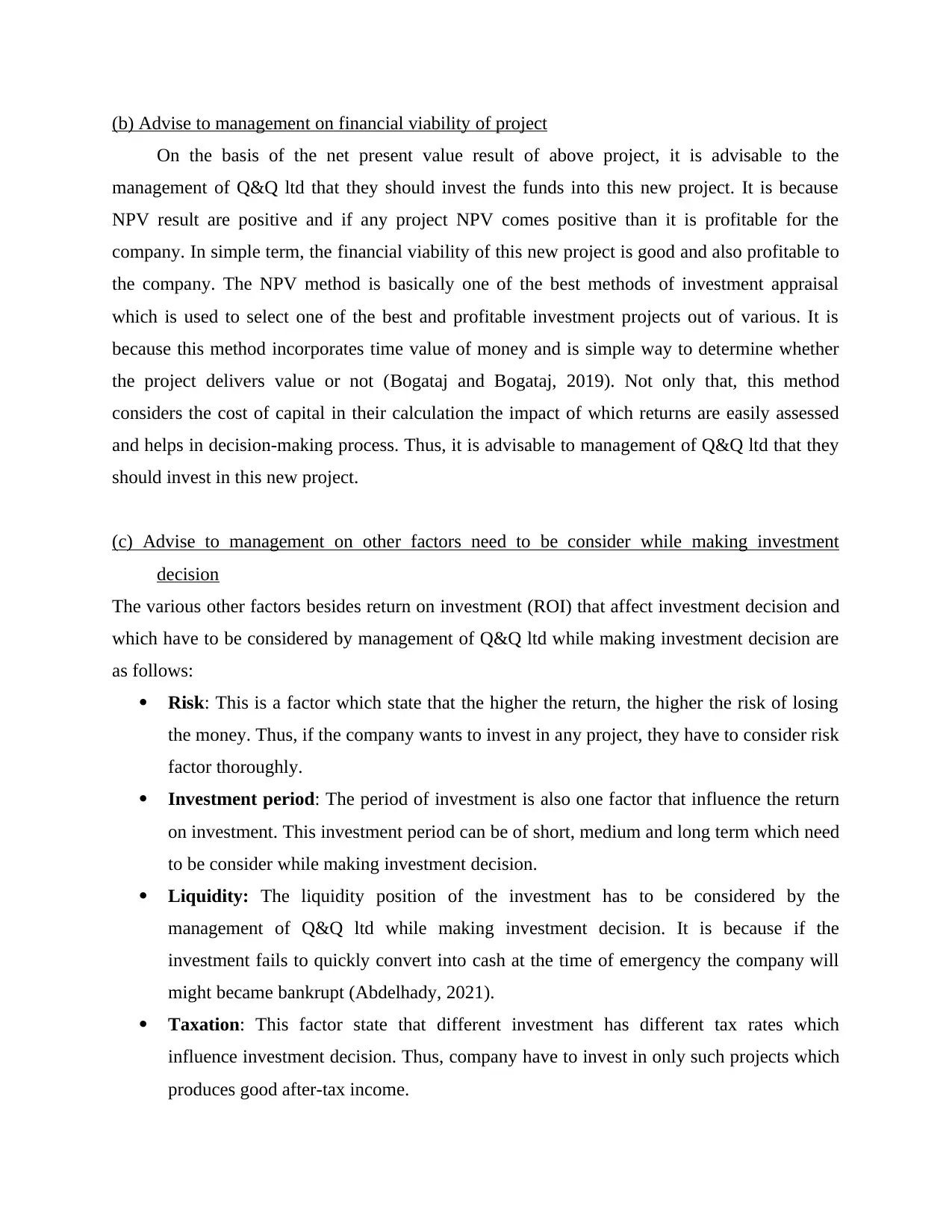
(b) Advise to management on financial viability of project
On the basis of the net present value result of above project, it is advisable to the
management of Q&Q ltd that they should invest the funds into this new project. It is because
NPV result are positive and if any project NPV comes positive than it is profitable for the
company. In simple term, the financial viability of this new project is good and also profitable to
the company. The NPV method is basically one of the best methods of investment appraisal
which is used to select one of the best and profitable investment projects out of various. It is
because this method incorporates time value of money and is simple way to determine whether
the project delivers value or not (Bogataj and Bogataj, 2019). Not only that, this method
considers the cost of capital in their calculation the impact of which returns are easily assessed
and helps in decision-making process. Thus, it is advisable to management of Q&Q ltd that they
should invest in this new project.
(c) Advise to management on other factors need to be consider while making investment
decision
The various other factors besides return on investment (ROI) that affect investment decision and
which have to be considered by management of Q&Q ltd while making investment decision are
as follows:
Risk: This is a factor which state that the higher the return, the higher the risk of losing
the money. Thus, if the company wants to invest in any project, they have to consider risk
factor thoroughly.
Investment period: The period of investment is also one factor that influence the return
on investment. This investment period can be of short, medium and long term which need
to be consider while making investment decision.
Liquidity: The liquidity position of the investment has to be considered by the
management of Q&Q ltd while making investment decision. It is because if the
investment fails to quickly convert into cash at the time of emergency the company will
might became bankrupt (Abdelhady, 2021).
Taxation: This factor state that different investment has different tax rates which
influence investment decision. Thus, company have to invest in only such projects which
produces good after-tax income.
On the basis of the net present value result of above project, it is advisable to the
management of Q&Q ltd that they should invest the funds into this new project. It is because
NPV result are positive and if any project NPV comes positive than it is profitable for the
company. In simple term, the financial viability of this new project is good and also profitable to
the company. The NPV method is basically one of the best methods of investment appraisal
which is used to select one of the best and profitable investment projects out of various. It is
because this method incorporates time value of money and is simple way to determine whether
the project delivers value or not (Bogataj and Bogataj, 2019). Not only that, this method
considers the cost of capital in their calculation the impact of which returns are easily assessed
and helps in decision-making process. Thus, it is advisable to management of Q&Q ltd that they
should invest in this new project.
(c) Advise to management on other factors need to be consider while making investment
decision
The various other factors besides return on investment (ROI) that affect investment decision and
which have to be considered by management of Q&Q ltd while making investment decision are
as follows:
Risk: This is a factor which state that the higher the return, the higher the risk of losing
the money. Thus, if the company wants to invest in any project, they have to consider risk
factor thoroughly.
Investment period: The period of investment is also one factor that influence the return
on investment. This investment period can be of short, medium and long term which need
to be consider while making investment decision.
Liquidity: The liquidity position of the investment has to be considered by the
management of Q&Q ltd while making investment decision. It is because if the
investment fails to quickly convert into cash at the time of emergency the company will
might became bankrupt (Abdelhady, 2021).
Taxation: This factor state that different investment has different tax rates which
influence investment decision. Thus, company have to invest in only such projects which
produces good after-tax income.
Paraphrase This Document
Need a fresh take? Get an instant paraphrase of this document with our AI Paraphraser
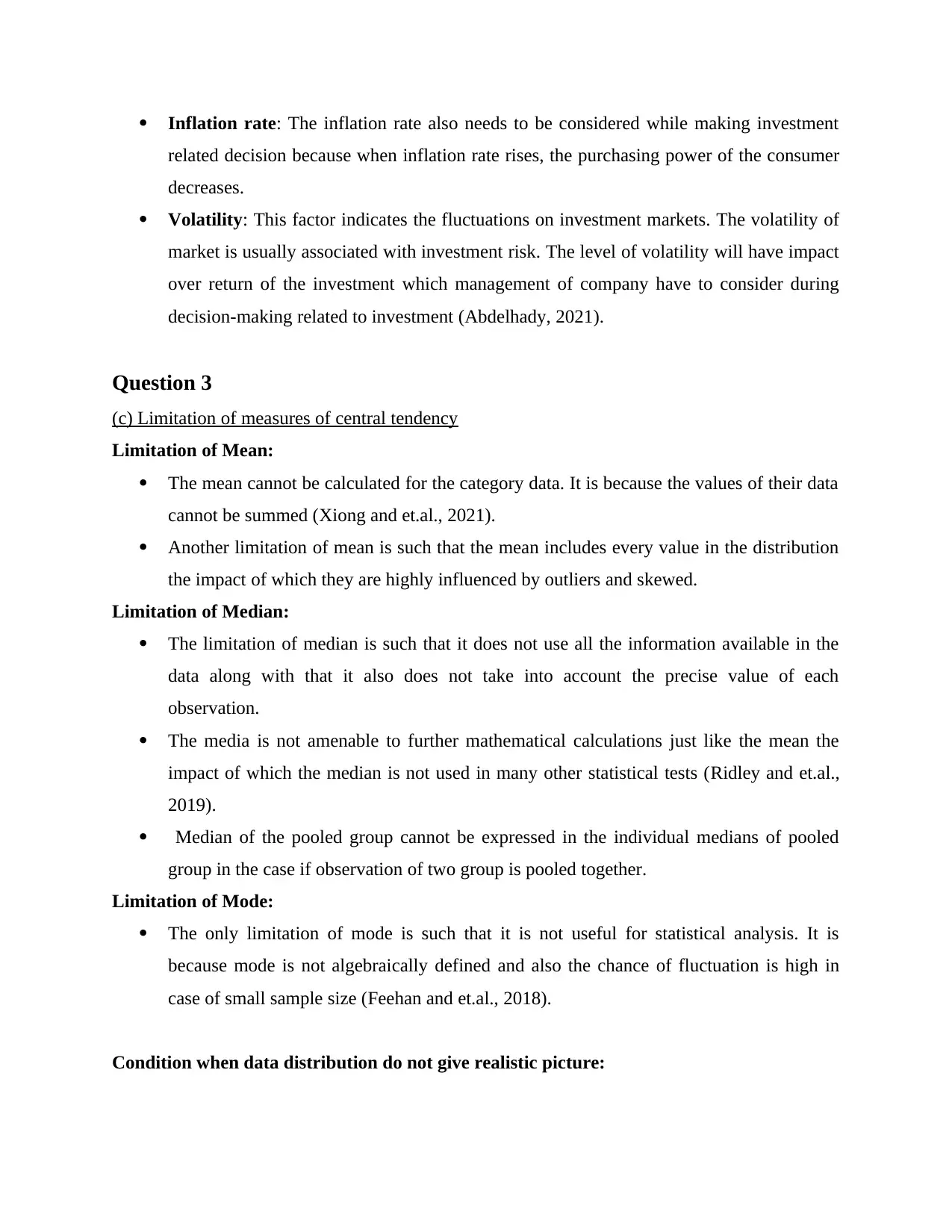
Inflation rate: The inflation rate also needs to be considered while making investment
related decision because when inflation rate rises, the purchasing power of the consumer
decreases.
Volatility: This factor indicates the fluctuations on investment markets. The volatility of
market is usually associated with investment risk. The level of volatility will have impact
over return of the investment which management of company have to consider during
decision-making related to investment (Abdelhady, 2021).
Question 3
(c) Limitation of measures of central tendency
Limitation of Mean:
The mean cannot be calculated for the category data. It is because the values of their data
cannot be summed (Xiong and et.al., 2021).
Another limitation of mean is such that the mean includes every value in the distribution
the impact of which they are highly influenced by outliers and skewed.
Limitation of Median:
The limitation of median is such that it does not use all the information available in the
data along with that it also does not take into account the precise value of each
observation.
The media is not amenable to further mathematical calculations just like the mean the
impact of which the median is not used in many other statistical tests (Ridley and et.al.,
2019).
Median of the pooled group cannot be expressed in the individual medians of pooled
group in the case if observation of two group is pooled together.
Limitation of Mode:
The only limitation of mode is such that it is not useful for statistical analysis. It is
because mode is not algebraically defined and also the chance of fluctuation is high in
case of small sample size (Feehan and et.al., 2018).
Condition when data distribution do not give realistic picture:
related decision because when inflation rate rises, the purchasing power of the consumer
decreases.
Volatility: This factor indicates the fluctuations on investment markets. The volatility of
market is usually associated with investment risk. The level of volatility will have impact
over return of the investment which management of company have to consider during
decision-making related to investment (Abdelhady, 2021).
Question 3
(c) Limitation of measures of central tendency
Limitation of Mean:
The mean cannot be calculated for the category data. It is because the values of their data
cannot be summed (Xiong and et.al., 2021).
Another limitation of mean is such that the mean includes every value in the distribution
the impact of which they are highly influenced by outliers and skewed.
Limitation of Median:
The limitation of median is such that it does not use all the information available in the
data along with that it also does not take into account the precise value of each
observation.
The media is not amenable to further mathematical calculations just like the mean the
impact of which the median is not used in many other statistical tests (Ridley and et.al.,
2019).
Median of the pooled group cannot be expressed in the individual medians of pooled
group in the case if observation of two group is pooled together.
Limitation of Mode:
The only limitation of mode is such that it is not useful for statistical analysis. It is
because mode is not algebraically defined and also the chance of fluctuation is high in
case of small sample size (Feehan and et.al., 2018).
Condition when data distribution do not give realistic picture:
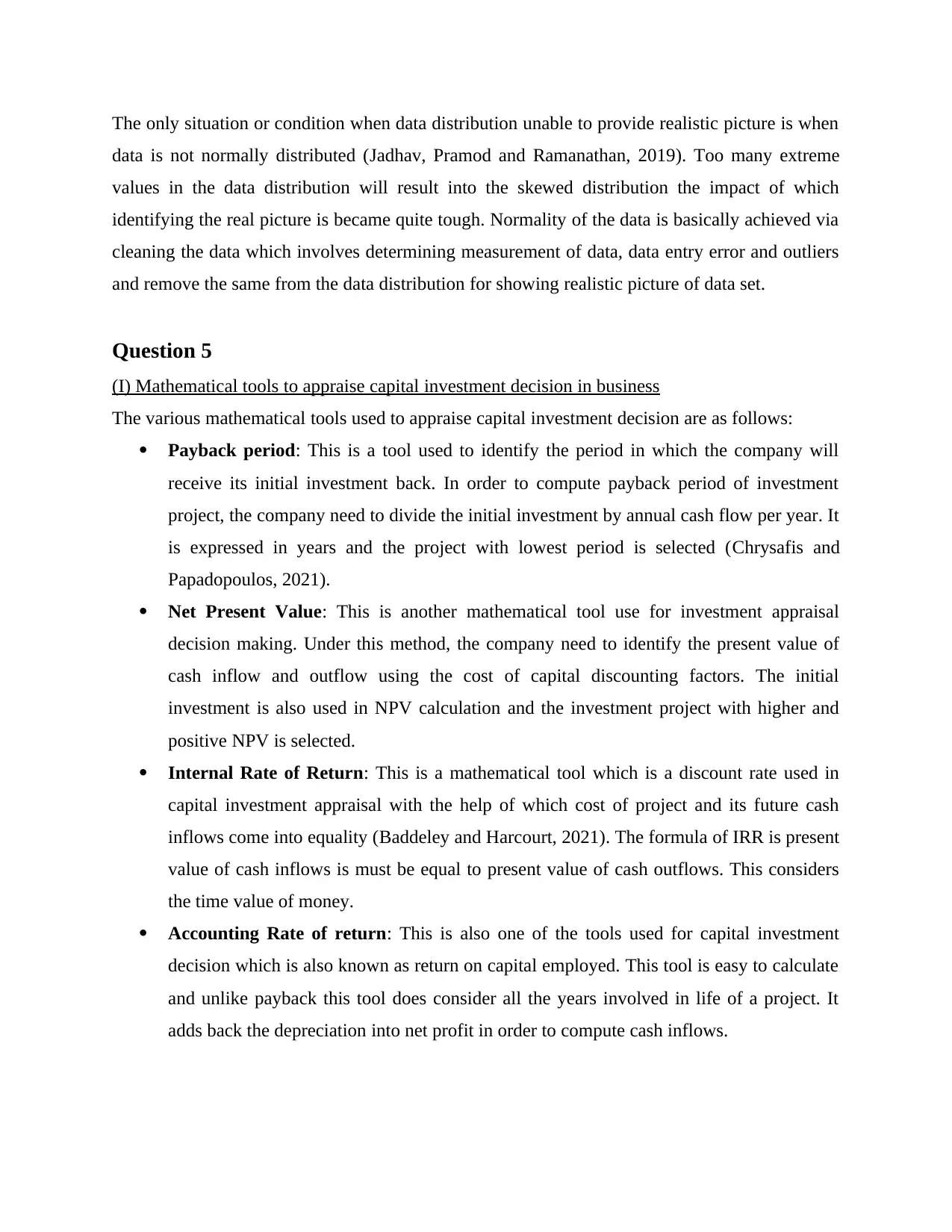
The only situation or condition when data distribution unable to provide realistic picture is when
data is not normally distributed (Jadhav, Pramod and Ramanathan, 2019). Too many extreme
values in the data distribution will result into the skewed distribution the impact of which
identifying the real picture is became quite tough. Normality of the data is basically achieved via
cleaning the data which involves determining measurement of data, data entry error and outliers
and remove the same from the data distribution for showing realistic picture of data set.
Question 5
(I) Mathematical tools to appraise capital investment decision in business
The various mathematical tools used to appraise capital investment decision are as follows:
Payback period: This is a tool used to identify the period in which the company will
receive its initial investment back. In order to compute payback period of investment
project, the company need to divide the initial investment by annual cash flow per year. It
is expressed in years and the project with lowest period is selected (Chrysafis and
Papadopoulos, 2021).
Net Present Value: This is another mathematical tool use for investment appraisal
decision making. Under this method, the company need to identify the present value of
cash inflow and outflow using the cost of capital discounting factors. The initial
investment is also used in NPV calculation and the investment project with higher and
positive NPV is selected.
Internal Rate of Return: This is a mathematical tool which is a discount rate used in
capital investment appraisal with the help of which cost of project and its future cash
inflows come into equality (Baddeley and Harcourt, 2021). The formula of IRR is present
value of cash inflows is must be equal to present value of cash outflows. This considers
the time value of money.
Accounting Rate of return: This is also one of the tools used for capital investment
decision which is also known as return on capital employed. This tool is easy to calculate
and unlike payback this tool does consider all the years involved in life of a project. It
adds back the depreciation into net profit in order to compute cash inflows.
data is not normally distributed (Jadhav, Pramod and Ramanathan, 2019). Too many extreme
values in the data distribution will result into the skewed distribution the impact of which
identifying the real picture is became quite tough. Normality of the data is basically achieved via
cleaning the data which involves determining measurement of data, data entry error and outliers
and remove the same from the data distribution for showing realistic picture of data set.
Question 5
(I) Mathematical tools to appraise capital investment decision in business
The various mathematical tools used to appraise capital investment decision are as follows:
Payback period: This is a tool used to identify the period in which the company will
receive its initial investment back. In order to compute payback period of investment
project, the company need to divide the initial investment by annual cash flow per year. It
is expressed in years and the project with lowest period is selected (Chrysafis and
Papadopoulos, 2021).
Net Present Value: This is another mathematical tool use for investment appraisal
decision making. Under this method, the company need to identify the present value of
cash inflow and outflow using the cost of capital discounting factors. The initial
investment is also used in NPV calculation and the investment project with higher and
positive NPV is selected.
Internal Rate of Return: This is a mathematical tool which is a discount rate used in
capital investment appraisal with the help of which cost of project and its future cash
inflows come into equality (Baddeley and Harcourt, 2021). The formula of IRR is present
value of cash inflows is must be equal to present value of cash outflows. This considers
the time value of money.
Accounting Rate of return: This is also one of the tools used for capital investment
decision which is also known as return on capital employed. This tool is easy to calculate
and unlike payback this tool does consider all the years involved in life of a project. It
adds back the depreciation into net profit in order to compute cash inflows.
⊘ This is a preview!⊘
Do you want full access?
Subscribe today to unlock all pages.

Trusted by 1+ million students worldwide
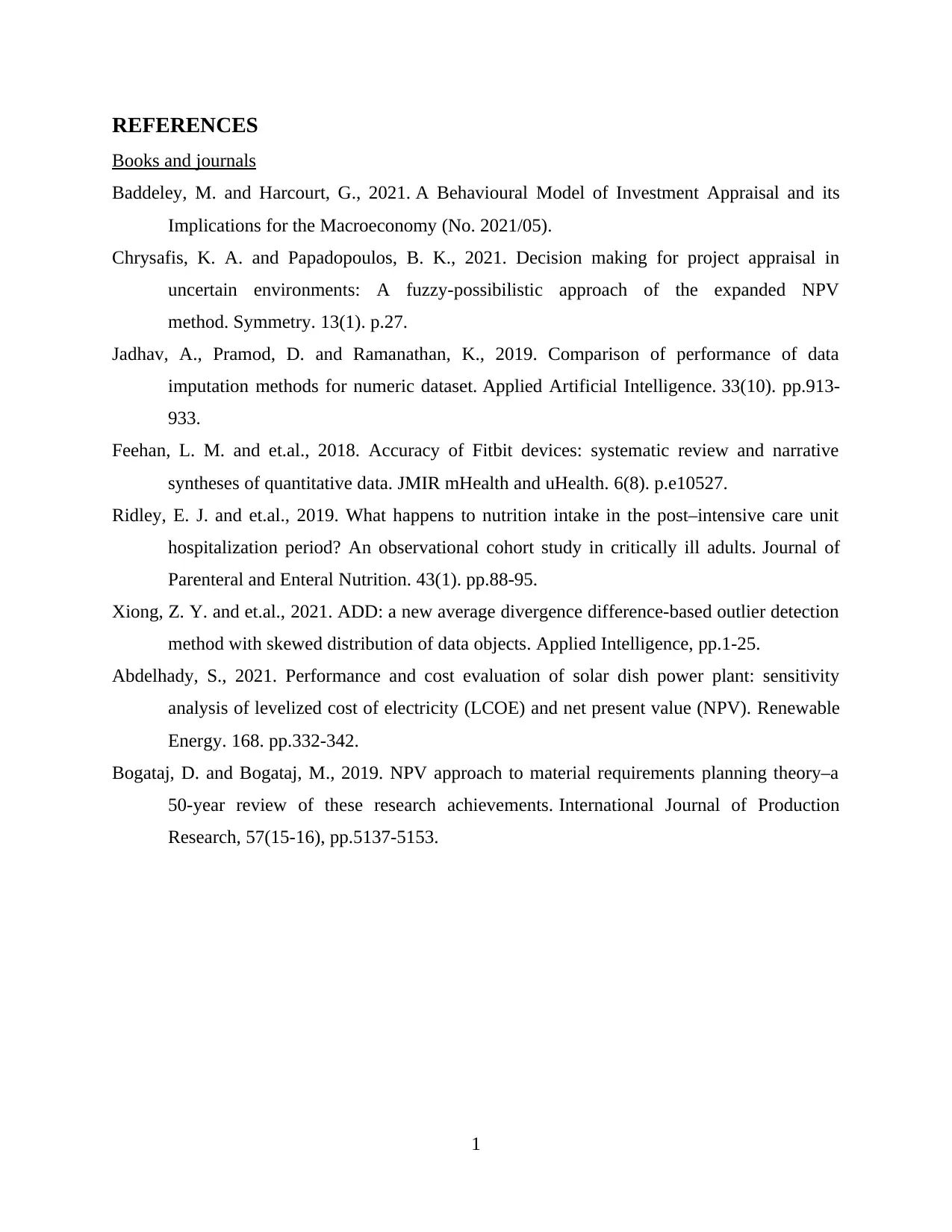
REFERENCES
Books and journals
Baddeley, M. and Harcourt, G., 2021. A Behavioural Model of Investment Appraisal and its
Implications for the Macroeconomy (No. 2021/05).
Chrysafis, K. A. and Papadopoulos, B. K., 2021. Decision making for project appraisal in
uncertain environments: A fuzzy-possibilistic approach of the expanded NPV
method. Symmetry. 13(1). p.27.
Jadhav, A., Pramod, D. and Ramanathan, K., 2019. Comparison of performance of data
imputation methods for numeric dataset. Applied Artificial Intelligence. 33(10). pp.913-
933.
Feehan, L. M. and et.al., 2018. Accuracy of Fitbit devices: systematic review and narrative
syntheses of quantitative data. JMIR mHealth and uHealth. 6(8). p.e10527.
Ridley, E. J. and et.al., 2019. What happens to nutrition intake in the post–intensive care unit
hospitalization period? An observational cohort study in critically ill adults. Journal of
Parenteral and Enteral Nutrition. 43(1). pp.88-95.
Xiong, Z. Y. and et.al., 2021. ADD: a new average divergence difference-based outlier detection
method with skewed distribution of data objects. Applied Intelligence, pp.1-25.
Abdelhady, S., 2021. Performance and cost evaluation of solar dish power plant: sensitivity
analysis of levelized cost of electricity (LCOE) and net present value (NPV). Renewable
Energy. 168. pp.332-342.
Bogataj, D. and Bogataj, M., 2019. NPV approach to material requirements planning theory–a
50-year review of these research achievements. International Journal of Production
Research, 57(15-16), pp.5137-5153.
1
Books and journals
Baddeley, M. and Harcourt, G., 2021. A Behavioural Model of Investment Appraisal and its
Implications for the Macroeconomy (No. 2021/05).
Chrysafis, K. A. and Papadopoulos, B. K., 2021. Decision making for project appraisal in
uncertain environments: A fuzzy-possibilistic approach of the expanded NPV
method. Symmetry. 13(1). p.27.
Jadhav, A., Pramod, D. and Ramanathan, K., 2019. Comparison of performance of data
imputation methods for numeric dataset. Applied Artificial Intelligence. 33(10). pp.913-
933.
Feehan, L. M. and et.al., 2018. Accuracy of Fitbit devices: systematic review and narrative
syntheses of quantitative data. JMIR mHealth and uHealth. 6(8). p.e10527.
Ridley, E. J. and et.al., 2019. What happens to nutrition intake in the post–intensive care unit
hospitalization period? An observational cohort study in critically ill adults. Journal of
Parenteral and Enteral Nutrition. 43(1). pp.88-95.
Xiong, Z. Y. and et.al., 2021. ADD: a new average divergence difference-based outlier detection
method with skewed distribution of data objects. Applied Intelligence, pp.1-25.
Abdelhady, S., 2021. Performance and cost evaluation of solar dish power plant: sensitivity
analysis of levelized cost of electricity (LCOE) and net present value (NPV). Renewable
Energy. 168. pp.332-342.
Bogataj, D. and Bogataj, M., 2019. NPV approach to material requirements planning theory–a
50-year review of these research achievements. International Journal of Production
Research, 57(15-16), pp.5137-5153.
1
Paraphrase This Document
Need a fresh take? Get an instant paraphrase of this document with our AI Paraphraser

2
1 out of 8
Related Documents
Your All-in-One AI-Powered Toolkit for Academic Success.
+13062052269
info@desklib.com
Available 24*7 on WhatsApp / Email
![[object Object]](/_next/static/media/star-bottom.7253800d.svg)
Unlock your academic potential
Copyright © 2020–2025 A2Z Services. All Rights Reserved. Developed and managed by ZUCOL.




